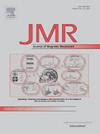双量子过滤23Na核磁共振和核磁共振:非均匀B0场中有序钠的选择性检测。
IF 1.9
3区 化学
Q3 BIOCHEMICAL RESEARCH METHODS
引用次数: 0
摘要
双量子过滤23Na核磁共振实验在过滤步骤中具有一个或两个“魔角”(54.7°)脉冲,广泛用于选择性观察与有序生物结构(“有序钠”)相互作用的钠离子,因此在其核磁共振光谱中表现出四极分裂的分布。这种方法最近被扩展到23Na MRI,其中传统的实验已经被修改,省略了180°脉冲,以减少人体研究期间射频能量的吸收。在这里,“魔角”双量子滤波23Na核磁共振实验(没有180°脉冲)分析了导致在非均匀B0场(“回波”)和那些不(“反回波”)重新聚焦的相干路径。结果表明,在非均匀B0场中,回波路径和反回波路径可以通过相位循环分离,并且反回波路径对整个信号的贡献很小。因此,提出了一种双量子滤波23Na核磁共振实验,该实验仅利用回波路径,从而在不使用180°脉冲的情况下实现B0不均匀性效应的完全重新聚焦。该方法在非均匀B0场的23Na核磁共振波谱和三组分模体的23Na核磁共振中得到了验证。本文章由计算机程序翻译,如有差异,请以英文原文为准。

Double-quantum filtered 23Na NMR and MRI: Selective detection of ordered sodium in an inhomogeneous B0 field
Double-quantum filtered 23Na NMR experiments with one or two “magic angle” (54.7°) pulses in the filter step are widely used for selective observation of sodium ions that are interacting with ordered biological structures (“ordered sodium”) and hence exhibit a distribution of quadrupolar splittings in their NMR spectrum. This approach has recently been extended to 23Na MRI where the conventional experiment has been modified, omitting the 180° pulse to reduce the absorption of radiofrequency energy during human studies. Here, the “magic angle” double-quantum filtered 23Na NMR experiment (without a 180° pulse) is analysed in terms of coherence pathways that lead to refocusing in an inhomogeneous B0 field (“echoes”) and those that do not (“antiechoes”). It is shown that the echo and antiecho pathways can be separated by phase cycling and that the antiecho pathway contributes very little to the overall signal in an inhomogeneous B0 field. Hence, a double-quantum filtered 23Na NMR experiment that utilises just the echo pathway and so achieves complete refocusing of the effects of B0 inhomogeneity without making use of a 180° pulse is proposed. The new method is demonstrated both in 23Na NMR spectroscopy in an inhomogeneous B0 field and in 23Na MRI of a three-component phantom.
求助全文
通过发布文献求助,成功后即可免费获取论文全文。
去求助
来源期刊
CiteScore
3.80
自引率
13.60%
发文量
150
审稿时长
69 days
期刊介绍:
The Journal of Magnetic Resonance presents original technical and scientific papers in all aspects of magnetic resonance, including nuclear magnetic resonance spectroscopy (NMR) of solids and liquids, electron spin/paramagnetic resonance (EPR), in vivo magnetic resonance imaging (MRI) and spectroscopy (MRS), nuclear quadrupole resonance (NQR) and magnetic resonance phenomena at nearly zero fields or in combination with optics. The Journal''s main aims include deepening the physical principles underlying all these spectroscopies, publishing significant theoretical and experimental results leading to spectral and spatial progress in these areas, and opening new MR-based applications in chemistry, biology and medicine. The Journal also seeks descriptions of novel apparatuses, new experimental protocols, and new procedures of data analysis and interpretation - including computational and quantum-mechanical methods - capable of advancing MR spectroscopy and imaging.

 求助内容:
求助内容: 应助结果提醒方式:
应助结果提醒方式:


